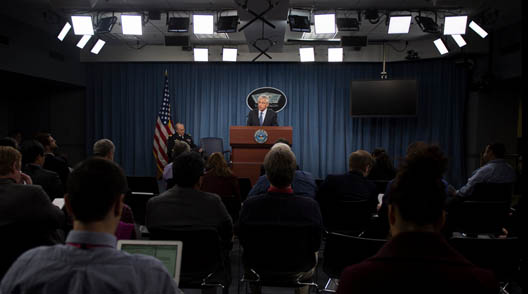
Chuck Hagel’s Press Conference Will Be a Hint
With the FY2015 defense budget and the Pentagon’s Quadrennial Defense Review (QDR) both due out next month along within a range of upcoming congressional hearings, how should we assess whether our defense establishment is preparing strategically to meet the key security challenges looming in our future?
There are two kinds of Secretaries of Defense: “coasters” who let the very strong, otherwise autonomous Pentagon bureaucracy drive their priorities to a least-common-denominator set of outcomes, the secretaries who do not prepare our defenses effectively for future challenges. And then there’s the “head knockers” who bear down hard on DOD components and produce creative friction and high tension to drive their own agenda and stark priorities.
When you boil down a Secretary of Defense’s thousands of decisions, there are really two major types: decisions on the development of future forces (investment and equipment decisions), and those on the employment of current forces (using the military capabilities that are already in the active force).
Developing Future Forces
Because of the decades-long timelines for DOD equipment choices to translate into fielded capabilities, each Secretary of Defense leaves to his or her successors the results of their capability decisions. For example, Secretary of Defense Donald Rumsfeld’s decisions in the late 1970s begat stealth capabilities, intelligence, surveillance, and reconnaissance capabilities, and others that enabled the 1991 Persian Gulf War to be so successful.
With enormous resource constraints and a very daunting set of complex security challenges looming before the United States, this is an absolutely critical time for a Secretary of Defense to make very hard, strategy-driven capability and budget decisions to leave relevant, effective capabilities to his successors. The defense challenges of the next ten years are formidable, with major potential challenges from China’s pacing military capabilities as well as a range of those posed by increasingly powerful non-state actors.
What will Secretary Hagel’s legacy to his successors be to help meet the challenges of 2024?
Will his decisions leave capabilities for future SECDEFs to deal with a loose nukes crisis as Pakistan disintegrates (e.g., the ability to detect nuclear materials from great distances)?
Will his decisions enable defense capabilities to deal with the coming age of biotech, in which the chances of bioterror or “bio-error” are increasing rapidly?
How do the Secretary’s decisions advance U.S. space capabilities, on which our military is highly reliant, but which also are increasingly vulnerable to Chinese and Russian counter-space capabilities?
Employing Current Forces
Force employment is a little understood “lever” that the SECDEF can pull to great effect. We have forces all over the world conducting “engagement” activities in a somewhat autonomous fashion. But the SECDEF can bear down on these activities and save our forces for the highest priorities by really setting tough priorities. A few previous Secretaries of Defense have done this, and once they have set such priorities, they have then asked each of their commanders afterwards, “What are you not doing anymore as a result of my guidance that you used to do?”
All of these decisions can be reflected in the QDR, which is essentially completed and which was Secretary Hagel’s best (but not only) opportunity to move the Department in desired directions on behalf of the nation’s defense.
As you listen to Secretary Hagel’s press conference today, and subsequent public discussions, these are the standards for judging whether his most important decisions have been effective.
Barry Pavel is Atlantic Council Vice President and Director of it’s Brent Scowcroft Center on International Security.
Image: Secretary of Defense Chuck Hagel briefs the press regarding his recommendations to the President for the fiscal year 2015 budget at the Pentagon Feb. 24, 2014. (Photo: US Department of Defense/Sgt. Aaron Hostutler USMC/Public Domain)
